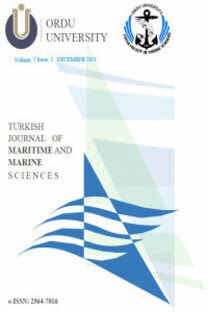The contribution of capsulated bacteria to the total bacterial community in the water column of the Northern Marmara Sea, Küçükçekmece Lagoon and Strait of Istanbul, Turkey
İstanbul Boğazı, yüzey suyu, ötrofikasyon, bakteri sayısı, kıyı gölü, denizler
Kuzey Marmara Deniz' i Küçükçekmece lagünü ve İstanbul Boğazı deniz suyu örneklerinde kapsüllü bakterinin toplam bakteri sayısına oranı
Bosphorus, surface water, eutrophication, bacterial count, lagoons, marine areas,
___
- Altuğ, G. and Güler, N., (2002). Determination of the Levels of Indicator, Bacteria, Salmonella spp. and Heavy Metals in Sea Snails (Rapana venosa) from the Northern Marmara Sea, Turkey TurkJ. Fish. andAquat Sci. 2:2 141-144.
- Azam, F. and Cho, B.C., (1987). Bacterial Utilization of Organic Matter in the Sea. In: Ecology of microbial communities. ( Fletcher M. ed.) Cambridge University Press, Cambridge, pp. 261-268.
- Bayer, M.E. and Bayer, M.H, (1981). Fast response of bacterial membranes to virus adsorption: A fluorescence study. Proc. Natl. Acad Sci. USA 78:5618-5622.
- Cho, B.C.and Azam F., (1990). Biogeochemical significance of bacterial biomass in the ocean's euphoric zone. Mar. Ecol. Prog. Ser. 63:253-259.
- Choi, J.W, Sherr, B.F, Sherr, E.B., (1999). Dead or alive? A large fraction of ETS -inactive marine bacterioplankton cells assessed by reduction of CTC, can become ETS-active with incubation and substrate addition. Aquat. Microb. Ecol. 18:105-115.
- Cole, J.J, Findlay, S., Pace, M.L., (1988). Bacterial production in fresh and saltwater ecosystems: a cross-system overview. Mar. Ecol. Prog. Ser. 43:1-10.
- Costerton, J.W., Cheng, KJ., Geesey, Ladd, T.L,Nickel, J.C., Dasgupta , M., and Marrie T.J., (1987). Bacterial biofilms in nature and disease. Annu. Rev. Microbiol 41:435-464.
- Decho, A.W., (1990). Microbial exopolymer secretions in ocean environments: their role (s) in food webs and marine processes. Oceanogr. Mar. Biol. Annu. Rev. 28: 73-153.
- Ducklow, H.W, Carlson, C.A., (1992). Oceanic bacterial production. Adv. Microb. Ecol. 12:113-181.
- Fuhrman, J.A and Noble, R.T., (1995).Viruses and protests cause similar bacterial mortality in coastal seawater. Limnon. Oceanogr. 40: 1236-1242.
- Gaman, PM., Sherrington, M. (1981). Food Poisoning and It's Prevention The Scienee of Food Pergamon Press pp 199-218.
- Grossman, S., (1994). Bacterial Bacterial activity in sea ice and open water of the Weddell Sea, Antarctica: a microautoradiographic study. Microb.Ecol.28:1-18
- Heissenberger, A., Leppard G.G., Herndl J.G, (1996). Relationship between the intracellular integrity and the morphology of the capsular envelope in attached and free-living marine bacteria. Appl. Environ. Microbiol 62:4521-4528.
- Herndl, G.J, (1991). Microbial biomass dynamics along a trophic gradient at the Atlantic Barrier Reef off Belize (Central America).P.S.Z.N.I: Mar.Ecol 12:41-51.
- Hobbie, J.E., Daley, R.J. and Jasper S., (1977). Use of Nucteopore filters for counting bacteria by epifluorescence microscopy. Appl. Environ. Microbiol. 33:1225-1228.
- Hoppe, H.G, (1978). Relations between active bacteria and heterotrophic potential in the sea. Neth. J. Sea Res. 13:78-98.
- Jacob, JM. (1989) Safe Food Handling World Health Organization, Genava 142 Jay, JM. (1986) The Microbial Spoilage of Foods Perspectives In Biotechnology and Applied Microbiology (ed., D.I Alanı and M. Mooyoung) Newyork pp 325-342.
- Kamer, M. Fuhrman, J.A., (1997). Determination of active marine bacterioplankton: a comparison of universal 16 S r RNA probes, autoradiography, and nucleoid staining. Appl. Environ. Microbiol. 63: 1208-1213.
- Plante, CJ, Shriwer A.G, (1998). Differential lysis of sedimentary bacteria by Arenicola marina L., examination of cell wall structure and exopolymeric capsules as correlates. J. Exp. Mar. Biol. Ecol. 229; 35-52.
- Porter, K.G., and Feig, Y.S., (1980). The use of DAPI for identifying and counting aquatic microflora. LimnolOceanogr. 25: 943-948.
- Stoderegger, K. Herndl , G.J., (1998). Production and release of bacterial capsular material and its subsequent utilization by marine bacterioplankton. Limnol. Oceanogr. 43: 877-884.
- Stoderegger, K.E., Herndl, GJ. (200 ^.Visualization of the exopolysaccharide bacterial capsule and its distribution in oceanic environments. Aquat. Microb. Ecol. 26: 195-199.
- Tabor, P.S, Neihof FLA., (1982). Improved method for determination of respiring individual microorganisms in natural waters. Appl. Environ. Microbiol. 43:1249-1255.
- Vosjan, J.H., van Noort, G.J., (1998). Enumerating nucleoid-visible marine bacterioplankto: bacterial abundance determined after storage of formalin fixed samples agrees with isopropanol rinsing method. Aquat. Microb. Ecol. 14: 149-154.
- Zweifel U.L, Hagström Â., (1995) Total counts of marine bacteria include a large fraction of non-nucleodid-containing bacteria (ghosts). Appl. Environ. Microbiol. 61: 2180-2185.
- ISSN: 1300-7122
- Yayın Aralığı: 1
- Başlangıç: 2018
- Yayıncı: -
Structural features of the Tuzla region, Istanbul
Kasım Cemal GÜVEN, Kartal ÇETİNTÜRK, Mutlu KÜÇÜK, Mustafa ALPASLAN, A. Adem TEKİNAY
Ostracoda (Crustacea) fauna of the Black Sea Coasts of Istanbul
Check-list of the brachyuran crabs of the Turkish straits system
